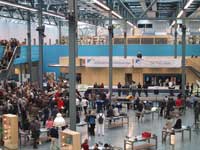Multi-sensory experience
People use all their sensory modalities when they interact with products, but the roles of touch, vision, smell, audition, and taste are not equivalent. We study the differences and commonalities in the roles senses play in human-product interactions. Also, we study how people integrate sources of conflicting sensory information and under what conditions this leads to surprise. In addition, we develop questionnaire and performance measures to assess differences in people's perceptual styles.
Projects in this field:
The Multi-sensory Product Experience
Rick Schifferstein
This NWO VIDI project studies the roles of the sensory modalities in product recognition and product experience (e.g., cognitive associations, mental images, memory characteristics, emotions). The project tries to yield understanding of the relative importance of modalities during product usage and other daily activities.
Sensory incongruity and surprise in product design (Phd. Project)
Geke Ludden
Promoter: Prof. Dr. Paul Hekkert
Supervisor: Assoc. Prof. Dr. Rick Schifferstein
This project investigates how people react when they perceive incongruent sensory information in a product. Experiencing surprise can be part of this reaction. This project is sponsored by the NWO VIDI program.
This project is related to the field design and emotion
Sensory dominance in product design (Phd. Project)
Anna Fenko
Promoter: Prof. Dr. Paul Hekkert
Supervisor: Assoc. Prof. Dr. Rick Schifferstein
The aim of this research is to assess the contribution of different sensory modalities in the consumer experience with products and to help designers in creating appropriate sensory attributes of products. This project is sponsored by the NWO VIDI program.
Other related projects:
Marco Rozendaal's project
Section Head
Paul HekkertDepartment of Industrial Design
Landbergstraat 15
2628CE Delft
room: 3B-09
phone: 015-2781346
email: p.p.m.hekkert@tudelft.nl
Staff:
René van EgmondRick Schifferstein
Pieter Desmet
Marieke Sonneveld
Geke Ludden
Erdem Demir
Gaël Laurans
Beatriz Russo
Elif Özcan Vieira
Rolf den Otter
Elvin Karana





